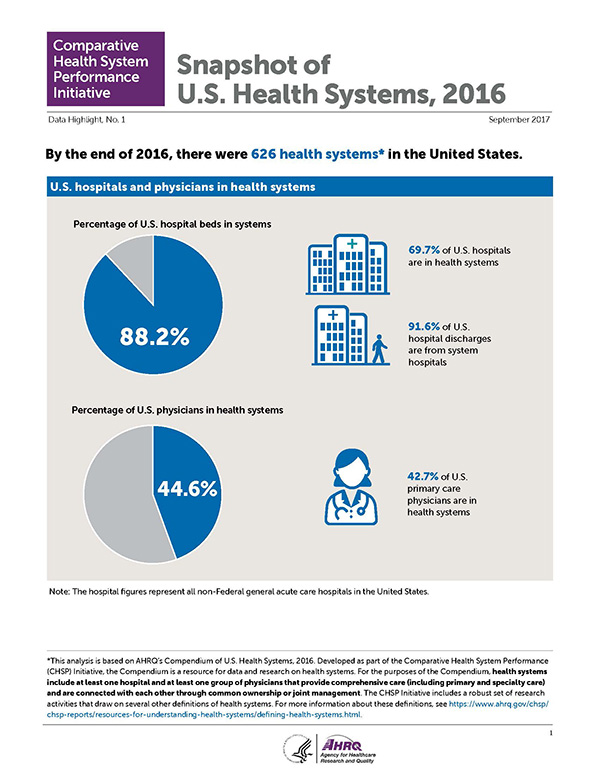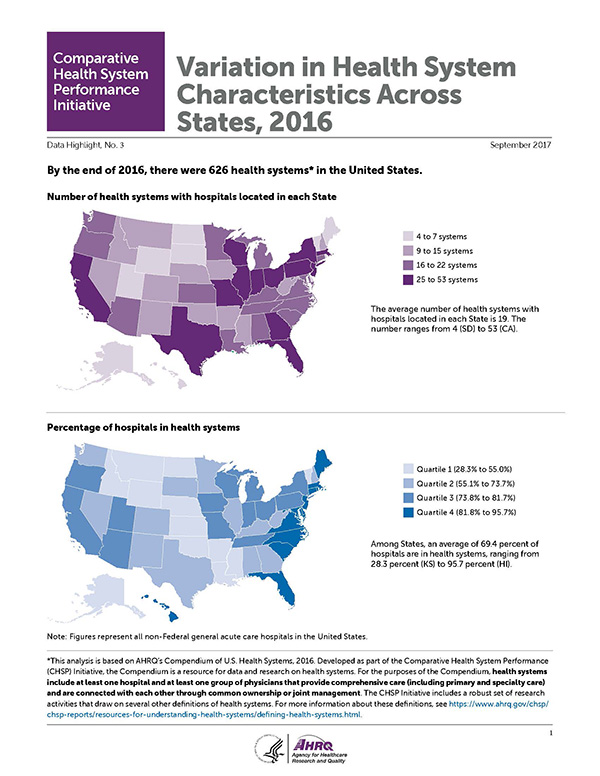
AHRQ Releases First Public Database on Nation’s Health Systems
Information about the size, structure and other characteristics of 626 health care organizations is included in AHRQ’s new Compendium of U.S. Health Systems, 2016, the nation’s first publicly available database that gives researchers, policymakers and health care administrators a snapshot of the nation’s health systems. The online resource was developed by the agency’s Comparative Health System Performance (CHSP) Initiative, a collaborative to examine systems’ use of evidence-based medicine and explore factors that contribute to high performance. The new compendium defines systems as networks of at least one hospital connected via ownership to one or more groups of physicians. Hospitals in these health systems account for roughly 88 percent of U.S. hospital beds and 92 percent of U.S. hospital discharges. The compendium identifies system characteristics such as the number of hospitals, acute care beds and physicians, as well as whether a system serves children. For more information, access Deputy Director Sharon B. Arnold’s AHRQ Views blog post, “With AHRQ’s New Compendium, Researchers and Policymakers Gain Fresh Insights into Nation’s Health Systems.”
DOWNLOAD THE COMPENDIUM
- Compendium of U.S. Health Systems, 2016 (CSV, 78 KB)Your computer should automatically prompt you to open the file in a spreadsheet application to view the data.
DATA HIGHLIGHTS
U.S. Health System Characteristics, 2016 (PDF, 904 KB)
Compendium of U.S. Health Systems, 2016
This inaugural edition of the Compendium -- Compendium of U.S. Health Systems, 2016 -- is composed of 626 U.S. health systems, defined in this analysis to include at least one hospital and at least one group of physicians providing comprehensive care, and who are connected with each other and with the hospital through common ownership or joint management.
The Compendium database includes:
- Columns A-D: System identification number (a unique number assigned by AHRQ), name, home office city, and State
- Columns E-I: Indicators of which data source identified the health system and health system identification numbers in the originating data source
- Columns J-R: Total counts of system hospitals, physician groups, physicians, primary care physicians, extent to which systems own or manage hospitals in multiple States, total acute care beds, discharges, and residents
- Columns S-AA: Variables identifying the extent to which systems include investor-owned hospitals, serve children, include teaching hospitals, and serve a disproportionately high share of low-income and uninsured individuals
If you would like to report a possible data discrepancy, please email doreen.bonnett@ahrq.hhs.gov.
- Snapshot of U.S. Health Systems, 2016 (PDF, 256 KB)
- U.S. Health System Characteristics, 2016 (PDF, 904 KB)
- Variation in Health System Characteristics Across States, 2016 (PDF, 1.14 MB)
More information about the definition of health systems and the methodology used in developing the Compendium:
Page last reviewed September 2017
Page originally created August 2017
Page originally created August 2017
Internet Citation: Compendium of U.S. Health Systems, 2016. Content last reviewed September 2017. Agency for Healthcare Research and Quality, Rockville, MD. http://www.ahrq.gov/chsp/compendium/index.html
























.png)









No hay comentarios:
Publicar un comentario